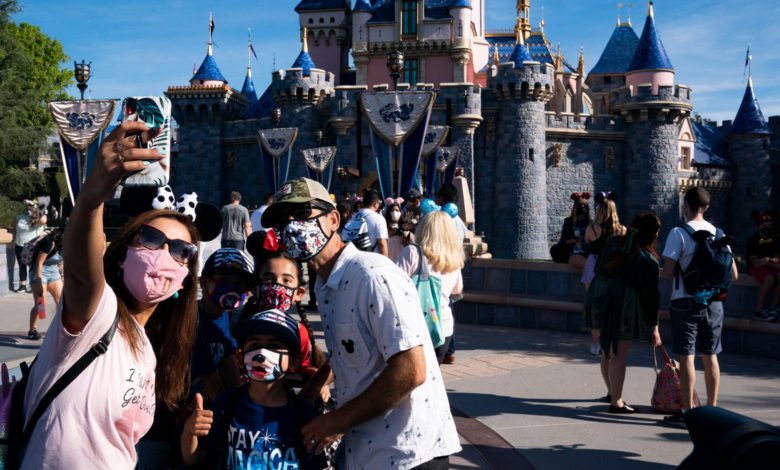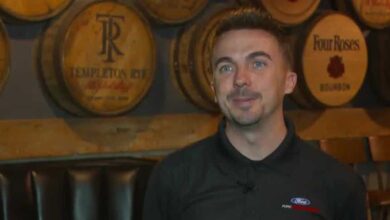
Disneyland reopening marks California’s turnaround
Disneyland swung open its gates to cheering visitors Friday, marking a dramatic turnaround in a state so overwhelmed with coronavirus cases just four months ago that patients were being treated in outdoor tents. (April 30)
AP
States that lifted business restrictions early during the COVID-19 pandemic benefited from a boost in economic activity, but those gains were limited or short-lived, as other states often caught up within a month, according to a study by Moody’s Analytics.
The aggressive states notched a longer-lasting advantage in employment but even in that critical category, the other states have narrowed the gap, the Moody’s analysis shows.
“I don’t see the states, by reopening aggressively, bought themselves that much additional growth,” says Moody's economist Adam Kamins.
At the same time, the early reopening states didn’t pay a significant price by falling behind the rest of the country after having to reinstate restrictions – such as barring indoor dining or lowering a business’s capacity limits -- because of COVID surges.
Grading Biden's economy: How U.S. economy has performed during Biden's first 100 days – in 7 charts
The big office comeback:Dallas takes the lead, while San Francisco and NY trail behind

With vaccinations rising and infections falling, both the health and economic crises spawned by the virus are on course to abate significantly by summer. The U.S. economy is expected to be fully open by July 4, leading to a swift return to near normal in all 50 states. Nearly one-third of the population has been fully vaccinated and that share is steadily rising, according to the Centers for Disease Control and Prevention.
This year, the nation is projected to record its strongest economic growth since 1984 as a result of both the rising vaccinations and trillions of dollars in government aid to households and businesses.
Along the way, however, some states stirred controversy by risking higher infection rates in the name of limiting the economic damage.
“The (states) that are most energetic about opening, they are doing tremendous business and this is what these numbers are all about,” then-President Donald Trump said last June.

Moody’s took a look at the 15 states that lifted all restrictions by the end of March 2021 -- Arkansas, Florida, Georgia, Iowa, Idaho, Missouri, Mississippi, Montana, North Dakota, Nebraska, Oklahoma, South Dakota, Tennessee, Texas and Wyoming. That group also imposed fewer constraints when the pandemic began a year ago and eased curbs sooner throughout the crisis, Kamins says.
Moody’s compared their economic performance to that of the more cautious states based on a “back-to-normal” index that includes measures such as hours worked at small businesses, employment, home sale listings, seated restaurant diners and the share of employees who have returned to offices.
On an index that topped out at 100 in late February 2020, before the crisis started, the aggressive states have maintained a lead that on average has kept them about 5% ahead of the rest of the country. Their edge widened during business reopenings in spring 2020 and narrowed during COVID surges last summer and late fall that hit them harder. Both early in the crisis and recently, the more cautious states caught up to the aggressive ones within 30 days, though at other times the bolder states held their advantage longer.
Since last June, the index has ranged from 80 to 89 in the states lifting constraints early and from 74 to 84 in the rest of the country.
A simpler way to compare the two groups of states is by looking at jobs. Since the aggressive states imposed fewer restrictions in the first place, their total employment at the nadir of the crisis in April 2020 was 12.1% below their February 2020 peak, compared to a 15.5% decline for the other states.

Show homes: Flush with cash, affluent Americans are chasing million dollar listings
Since that point, however, total payrolls have climbed 10.6% for the more cautious states and just 9.2% for the aggressive states despite their earlier reopening, according to Moody’s and Labor Department figures. That has allowed the more cautious states to partly close the gap. They’re now 6.5% below their pre-pandemic employment, compared to 4% for the aggressive states.

One reason the aggressive states’ advantage has been limited is that, among both groups of states, most white-collar workers still haven’t returned to offices, Kamins says. That has continued to suppress sales at downtown restaurants, shops and other outlets.
“Many companies are taking it upon themselves to exercise more caution than elected leaders,” Kamins wrote in a report.
Similarly, he says, a state’s lifting of restrictions doesn’t necessarily mean all residents are comfortable going back to their normal shopping, dining and travel activities.
Tom Jackson, regional economist at IHS Market, says he generally agreed with the Moody’s study but adds that other factors also have affected economic and job growth, such as the oil price crash that wiped out jobs in Texas early in the pandemic. That, he says, can make it difficult to isolate the impacts of reopening.
Civic life: The top-selling Honda car gets a new look but its popularity is under threat
He also noted that states such as New York and New Jersey that suffered higher infection rates and were slower to ease restrictions “have had trouble restoring those lost jobs.”

Now that vaccinations are spreading and states are reopening across the country, the disparity between the aggressive and more cautious states is likely to narrow further, Kamins says. And the aggressive states may be more likely to hit snags because they have more residents who are hesitant to get vaccinated.
For those states, “The path to normalcy could hit speed bumps in the months ahead,” Kamins wrote in the report.
Published
Updated
Source link








